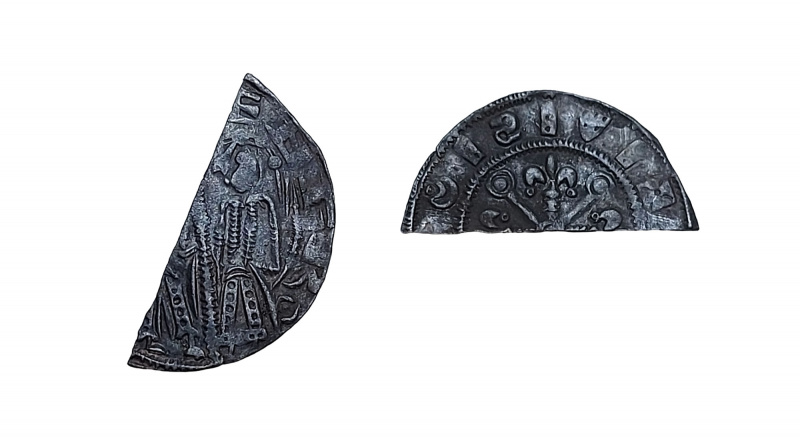Cut halfpenny of Stephen
It was during the Anglo-Saxon period that pennies first started to be cut into two or four pieces to make halfpennies and farthings. This continued up to the reign of Edward I when enough round halfpennies and farthings were struck for the cutting up of coins to cease. Cut coins of the Anglo-Saxon and Norman periods are quite rare but examples dating from the reigns of Henry II, Richard I, John and Henry III are very common.
Featured here is a cut halfpenny that was struck during the turbulent reign of King Stephen. It was found last weekend by Shaughn Tyreman, who asked if I could give him some idea of its value.
Shaughn’s find has two standing figures on the obverse. One is only partly visible but the other stands out very well. The partially visible figure is King Stephen and the other is his wife, Matilda. The name Matilda was very popular during the 11th and 12th centuries and can lead to confusion.
The two Matildas
When Henry I died his only legitimate child was his daughter Matilda, who was married to Geoffrey Plantagenet, Count of Anjou. Well before Henry died he had secured a promise from the leading magnates that they would accept Matilda as Queen of England. However, soon after the death of Henry I his nephew, Stephen of Blois, took the throne. This eventually led to years of conflict between Matilda and Stephen.
By 1141 Matilda had the support of the Earls of Gloucester and Chester and of Henry of Blois (Bishop of Winchester and Stephen’s brother). On 2 February Stephen was defeated in battle and taken prisoner at Lincoln. For a few months it looked as if Matilda had won. At a council held at Winchester Bishop Henry said it was the clergy’s prerogative to choose and consecrate a king or queen. The following day a delegation from London arrived and instead of agreeing with Bishop Henry they said that King Stephen should be released. Matilda is then said to have proceeded to London, where she showed her most arrogant face and promptly levied a tax on the city.
Not content with upsetting the Londoners, she then quarrelled with the Bishop of Winchester and was expelled from the city. Matilda was determined to take hold of the bishop, so with the aid of Robert of Gloucester and a small army she laid siege to the bishop’s palace, Wolvesey Castle. Queen Matilda, Stephen’s wife, arrived with a much larger army and surrounded the besiegers. Earl Robert planned to break out and get his half-sister to the safety of Bristol, which was in the hands of her supporters; she managed to escape but Robert was captured. This was a loss that was too great to suffer and there was no other option open but to exchange him for Stephen. With the king free again to organise the war, Matilda’s chance of victory was gone. However, she still possessed enough support to prevent Stephen from gaining total victory.
Whilst we hear much about Matilda the daughter of Henry I, we hear much less about Queen Matilda, the wife of Stephen. However, the latter always gave her full support to her husband and had her army not captured Robert of Gloucester, which led to Stephen being set free, the other Matilda could have won the war.
Valuation
Back to Shaughn’s cut halfpenny, which is listed in the Standard Catalogue as number 1315 and is an example of the York group. It is without doubt one of the most attractive cut halfpennies dating from the reign of Stephen I have ever seen. It is well and centrally struck from sharp dies and would grade good VF for the issue. Had I dug it up I would still be sleeping with it under my pillow, just in case I woke up during the night and wanted to have another look at it. As a cut halfpenny it might be unique but, as I’ve said many times before, cut coins are worth much less than whole pennies.
A whole penny of the same type graded as VF but with the edge slightly chipped, recently sold at auction for £10,000. Another specimen, VF but with a wavy flan, a flat area and an edge chip, sold for £8,500. Another, described as VF but with a large piece missing from the edge, sold for roughly £4,200.
If I were cataloguing Shaughn’s coin for sale at auction I would set the pre-sale estimate at £2,000 to £3,000. This might seem like a high estimate for a cut halfpenny but its eye appeal is second to none.
Valuation Service
If you would like your coin identified or valued, please read about my valuation service and contact me


Absolute stunning coin and find, I collect and purchase cut coins, ive only seen one other cut half stephen and matilda, unfortunately I do not have one in my collection, as to the price, Normally a 10th to an 8th of the price of a whole coin that said this is rare, and if it came on the market, there would be at least 3 or more people that would want it, so the price would be what it sells for, if not already sold auction would be your best bet of finding the true price.